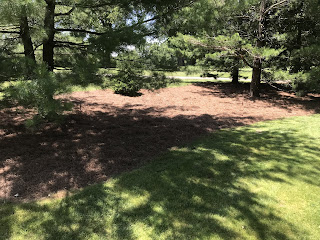 |
| Pythium blight in #8 rough. Chemical application was applied as soon as detected. |
 |
| Dollar spot on #9 approach. The disease has been suppressed. |
The grounds department will do everything possible to keep as much of the cool-season turf alive and healthy but we could use everyone's help during the summer. We ask that all golfers try and limit the amount of time that carts are in the fairways, and use the ninety- degree rule when entering and exiting during days of extreme heat (close to or over 90 degrees). On these days the grass is so stressed simply driving over them can cause severe damage. This type of damage usually occurs during the middle of the day when the sun is at its peak and the temperatures are the highest. Limiting cart traffic to the rough as much as possible will greatly help improve fairway conditions.
 |
| Golf cart traffic damage, due to the hot conditions, on #11 fairway |
There is some grasses that absolutely thrive in these conditions and they are the warm-season varieties. Zoysia and Bermuda are the most popular of these types for our area. We do have a decent amount of Bermuda at WHCC and it is basking in the heat and sun as I write this. It looks lush and healthy and is a good plant for southern facing slopes where many other grasses struggle in the summer months.
 |
| Bermuda grass on #15 lovin it! |
The irrigation system is now up and running and is being utilized frequently. The wet conditions in the spring and early summer caused many of the turf roots to become shallow. They were acclimated to the abundant moisture close to the surface and did not need to grow deeper. Once the heat cranked up and the rainfall stopped the turf needed frequent irrigation cycles to keep the roots moist in the top soil layers. Even with the nightly use of the irrigation system, certain areas will need more water then others-for example, mounds, localized dry spots (LDS), and high traffic areas. The most efficient way to combat this is through hand watering. So do not be surprised to see many of us out with hoses irrigating and syringing problem turf areas.
 |
| LDS starting to form on #8 green |
The horticulture crew was able to complete the landscape design behind #14 tee last month. The bed containing spruce trees and white pines located behind #17 green was cleaned out and mulched with pine straw. The fence behind #14 tee was extended. Emerald green arborvitaes and climbing hydrangea vines were the plants used to screen the unsightly view of the fence. The use of the pine straw gives it a very natural look and it will continue to grow and fill in providing a beautiful addition to the golf course for years to come.
Cool temperatures, and heads, will eventually prevail as it does after every summer season at WHCC, but until then, the grounds crew will utilize all the tools available to keep the cool-season grasses cool (and alive) in the summer heat.
Brad Piecuch
Assistant Superintendent/Horticulturist



